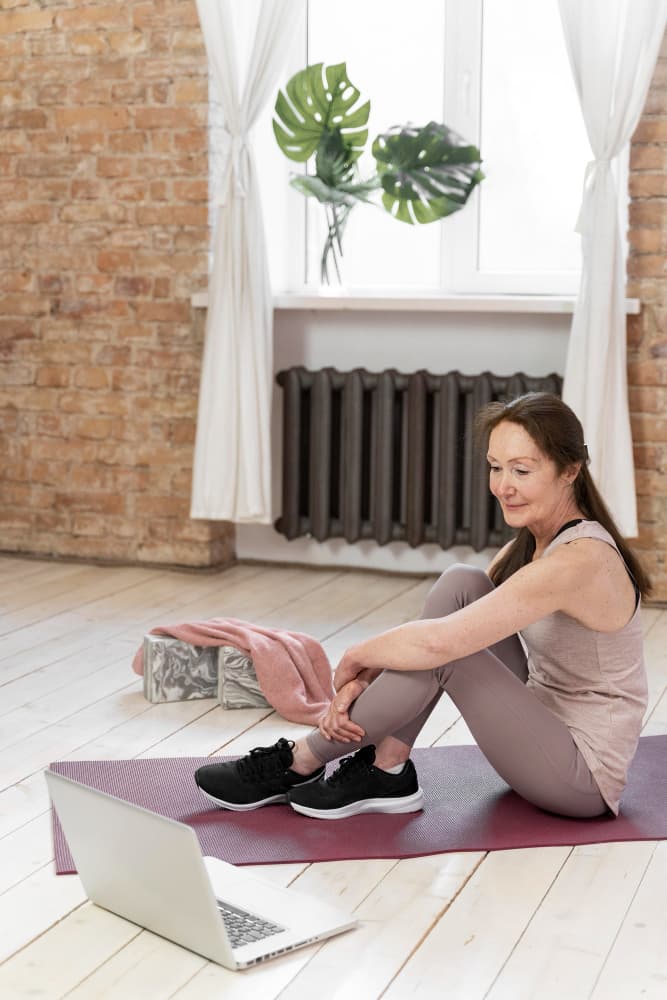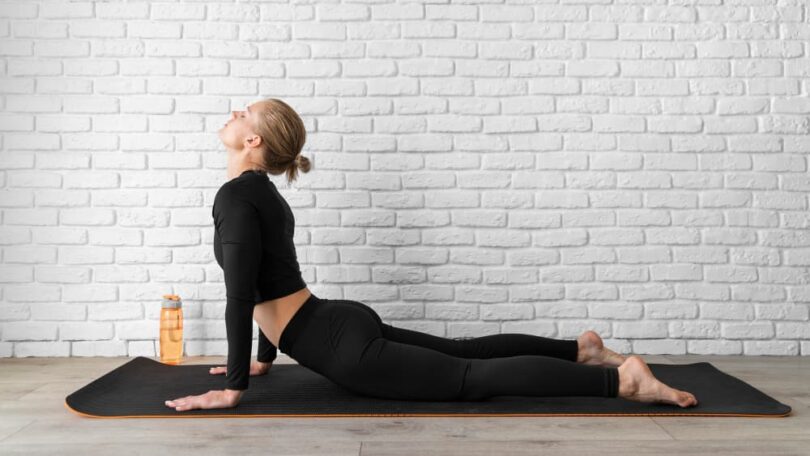When it comes to gentle exercise that nurtures both mind and body, Gentle Somatic Yoga for Beginners stands out. This practice combines mindful movement and neuromuscular re-education to help you reconnect with your body, relieve stress, and manage chronic pain. It’s perfect for those new to yoga or looking for a gentler approach. Let’s dive into how you can start your journey with gentle somatic yoga today.
Table of Contents
What is Gentle Somatic Yoga?
Definition and Concept
Gentle Somatic Yoga (GSY) is a blend of somatic movement and traditional yoga. It’s designed to release tension and improve body awareness. Originating from Hanna Somatics, this method focuses on slow, mindful movements that help retrain the nervous system.
Brief History and Origin
Developed by James Knight, GSY is rooted in the principles of Hanna Somatics and incorporates elements of yoga to create a holistic approach to self-care. It’s not about pushing your limits but rather about listening to your body.
Differences from Traditional Yoga
While traditional yoga emphasizes flexibility and strength, GSY is more about mindful movement and internal awareness. The goal is to release habitual patterns of tension and create a sense of ease in the body.
Benefits of Gentle Somatic Yoga
Physical Benefits
Practicing Gentle Somatic Yoga can alleviate chronic pain, improve posture, and enhance mobility. The gentle, controlled movements help release muscle tension and promote relaxation.
Mental and Emotional Benefits
GSY is not just a physical practice. It also aids in reducing stress and anxiety, promoting a sense of calm and well-being. The mindful aspect of the practice helps quiet the mind and brings a deeper sense of peace.
Scientific Research Supporting Benefits
Several studies highlight the effectiveness of somatic practices in managing chronic pain and stress. Research shows that these mindful movements can significantly impact overall health and wellness.
Who Should Practice Gentle Somatic Yoga?
Suitable Age Groups
GSY is accessible to all age groups, from young adults to seniors. Its gentle nature makes it ideal for anyone looking for a low-impact exercise option.
Conditions It Helps With
This form of yoga is particularly beneficial for those with chronic pain, arthritis, or stress-related conditions. It’s also a great choice for people recovering from injuries.
Contraindications
While GSY is generally safe, it’s always wise to consult with a healthcare professional if you have any serious health concerns. Avoid pushing through pain or discomfort during your practice.
Getting Started with Gentle Somatic Yoga
Preparing for Your Practice
Before diving into your Gentle Somatic Yoga routine, it’s essential to set the stage for a successful session. Find a quiet space where you won’t be interrupted. Wear comfortable clothing that allows for easy movement. You don’t need much in terms of props, but a yoga mat and a few cushions can be helpful.
What You Need
- Space: A quiet, uncluttered area where you can move freely.
- Clothing: Comfortable, stretchy attire.
- Props: A yoga mat, cushions, or blankets for support.
Setting Intentions for Your Practice
Starting with a clear intention can transform your practice. Take a moment to think about what you want to achieve. Whether it’s stress relief, improved mobility, or a deeper connection with your body, setting an intention can guide your practice.
Basic Principles and Techniques
Introduction to Neuromuscular Re-education
At the heart of Gentle Somatic Yoga is neuromuscular re-education. This involves retraining your brain and nervous system to release chronic muscle tension. Unlike traditional stretching, these movements are slow and deliberate, focusing on awareness and control.
Key Movements and Techniques
- Pandiculation: This is a natural movement that resets muscle length and tension. Think of how a cat stretches – that’s pandiculation. It involves contracting a muscle, slowly releasing it, and then completely relaxing it.
- Mindful Movement: Each movement is performed with full attention to how your body feels. This mindfulness helps deepen the connection between your mind and body.

Common Poses and Movements
Detailed Descriptions of Basic Poses
- Arch and Curl: Lie on your back with your knees bent and feet flat on the floor. Slowly arch your back, lifting your lower ribs, then curl your spine, bringing your ribs towards your hips.
- Side Bend: Sit comfortably with your legs crossed. Reach one arm over your head and gently bend to the opposite side, feeling a stretch along the side of your body.
Step-by-Step Instructions
Each pose should be done slowly and mindfully. Begin with a small range of motion and gradually increase as you become more comfortable. Remember, the goal is not to force your body but to move with awareness and ease.
Modifications for Beginners
If you’re new to Gentle Somatic Yoga, you might need to modify some poses. Use cushions or blankets for support, and don’t hesitate to take breaks. The key is to listen to your body and move at your own pace.
That’s the essence of getting started with Gentle Somatic Yoga. In the next part, we’ll discuss how to build your practice and integrate it into your daily routine.
Building Your Practice
Creating a Routine
To get the most out of Gentle Somatic Yoga, it’s important to establish a regular routine. Consistency helps your body and mind adapt to the movements and benefits of the practice. Aim for short, daily sessions rather than occasional longer ones.
How Often to Practice
For beginners, practicing Gentle Somatic Yoga three to four times a week can be beneficial. As you become more comfortable, you can increase the frequency. The key is to listen to your body and not overdo it.
Structuring a Session
A typical session might start with a few minutes of mindful breathing to center yourself. Follow this with 15-20 minutes of gentle movements, focusing on different parts of the body. End with a short relaxation period, lying down and allowing your body to absorb the benefits of the practice.
Progressing in Gentle Somatic Yoga
Signs of Progress
Progress in Gentle Somatic Yoga is often subtle. You might notice increased flexibility, less pain, or a greater sense of calm. Celebrate these small victories as they indicate your body is responding well to the practice.
Tips for Advancing Your Practice
- Increase Awareness: Pay close attention to how your body feels during each movement.
- Go Slow: Slow, mindful movements are more effective than rushing through poses.
- Stay Consistent: Regular practice is more beneficial than sporadic, intense sessions.
Combining Gentle Somatic Yoga with Other Practices
Integrating Gentle Somatic Yoga with other forms of exercise can provide a balanced approach to wellness. Combining it with activities like walking, swimming, or even traditional yoga can enhance overall health.
Integrating with Other Forms of Exercise
Adding Gentle Somatic Yoga to your routine can complement more vigorous activities by promoting flexibility and relaxation. It’s especially helpful as a warm-up or cool-down to ease into or out of more strenuous workouts.
Benefits of a Holistic Approach
A holistic approach to fitness, which includes Gentle Somatic Yoga, can lead to improved physical health and mental well-being. By addressing the body and mind together, you create a balanced, sustainable practice that supports long-term health.
Tips and Best Practices
Avoiding Common Mistakes
Starting a new practice like Gentle Somatic Yoga can be exciting, but it’s easy to make mistakes. Here are some common pitfalls to avoid:
What to Watch Out For
- Rushing Through Movements: The essence of somatic yoga lies in slow, mindful movements. Don’t rush through poses; instead, savor each movement.
- Ignoring Pain: While mild discomfort can be a part of any physical practice, sharp pain is a red flag. Listen to your body and adjust accordingly.
- Skipping Warm-ups: Always start with a gentle warm-up to prepare your body for the session.
Correcting Common Errors
If you find yourself rushing or feeling pain, take a step back. Reassess your movements and focus on mindful practice. It’s better to do fewer movements correctly than to do many with poor form.
Staying Motivated
Maintaining motivation can sometimes be challenging, especially with a new practice. Here are a few tips to keep your practice engaging and enjoyable.
Setting Realistic Goals
Set achievable goals that match your lifestyle and fitness level. Start with small, manageable milestones and gradually increase them. This approach helps maintain motivation and prevents burnout.
Keeping Your Practice Interesting
Variety is the spice of life, and it applies to yoga too. Mix up your routines by trying new poses or incorporating different sequences. Consider joining a class or following along with online videos for fresh inspiration.
Incorporating Gentle Somatic Yoga into Daily Life
Beyond the mat, Gentle Somatic Yoga principles can enhance your daily activities. Here’s how to weave this mindful practice into everyday life:
- Mindful Movement: Pay attention to how you move throughout the day. Incorporate gentle, somatic movements in your routine activities.
- Regular Breaks: Take short breaks during your workday to stretch and practice a few somatic movements. It can refresh your body and mind.
- Breathing Exercises: Use somatic breathing techniques to manage stress and stay centered.
Resources and Further Learning
Recommended Books and Videos
To deepen your understanding and practice of Gentle Somatic Yoga, there are numerous books and videos available. These resources provide detailed explanations, guided sessions, and insights into the principles behind the practice.
Top Books on Gentle Somatic Yoga
- “Somatics: Reawakening The Mind’s Control Of Movement, Flexibility, And Health” by Thomas Hanna
- This foundational book delves into the principles of somatic movement.
- “The Body of Life: Creating New Pathways for Sensory Awareness and Fluid Movement” by Thomas Hanna
- This is a great follow-up read for those looking to expand their knowledge.
- “Awakening Somatic Intelligence: The Art and Practice of Embodied Mindfulness” by Risa F. Kaparo
- Explores the intersection of somatics and mindfulness.
Useful YouTube Channels and Online Resources
- Yoga with Rachel – Offers a variety of somatic yoga exercises specifically designed for beginners.
- James Knight – Gentle Somatic Yoga – Founder of Gentle Somatic Yoga, provides full-length classes and workshops.
Joining a Class or Workshop
While practicing on your own is beneficial, joining a class or workshop can provide additional support and community.
Benefits of Professional Guidance
Working with a certified instructor can help you refine your technique, stay motivated, and ensure you’re practicing safely. Instructors can offer personalized adjustments and feedback that you might not get from solo practice.
Finding Local or Online Classes
- Local Studios: Check out local yoga studios or community centers for classes in Gentle Somatic Yoga.
- Online Platforms: Many online platforms offer live or recorded classes. Websites like Yoga Journal can help you find reputable instructors and classes.
Further Learning Opportunities
If you’re interested in teaching or deeply immersing yourself in the practice, consider taking certification courses. These programs provide in-depth training and can open up opportunities to share the benefits of Gentle Somatic Yoga with others.
FAQs:
Is somatic yoga good for beginners?
Yes, somatic yoga is excellent for beginners. Its gentle and mindful approach makes it accessible to people of all fitness levels. The focus on slow, deliberate movements helps you learn body awareness and proper technique without the risk of overexertion or injury. It’s an ideal way to start a yoga practice, especially if you’re new to physical activity or looking for a low-impact option.
How do I learn somatic yoga?
Learning somatic yoga can be straightforward and enjoyable. Here are some steps to get you started:
Online Resources: There are many videos and tutorials available online. Channels like James Knight – Gentle Somatic Yoga offer comprehensive guides and practice sessions.
Books: Reading books on somatic yoga can provide in-depth knowledge and step-by-step instructions. Consider titles like “Somatics” by Thomas Hanna.
Classes: Joining a local or online class can give you structured guidance from certified instructors. Look for classes at community centers, yoga studios, or on platforms like Yoga Journal.
Workshops: Participating in workshops can deepen your understanding and practice through intensive, focused sessions.
What is somatic yoga?
Somatic yoga combines traditional yoga with somatic movements. It focuses on slow, mindful exercises that help re-educate the neuromuscular system, relieve chronic tension, and increase body awareness. Unlike traditional yoga, which emphasizes flexibility and strength, somatic yoga prioritizes internal awareness and the release of habitual muscle patterns. This practice is designed to create a sense of ease and freedom in the body.
What is a somatic workout for beginners?
A somatic workout for beginners involves simple, gentle movements that promote body awareness and relaxation. Here are some typical components:
Pandiculation: Mimicking the natural stretch and release movements you see in animals like cats stretching. This involves contracting a muscle group, slowly releasing it, and then fully relaxing.
Mindful Breathing: Incorporating deep, mindful breaths to calm the nervous system and focus the mind.
Basic Movements: Simple exercises such as the arch and curl, side bends, and gentle twists are performed slowly and with full attention to bodily sensations.
Relaxation: Ending the session with a period of rest, lying down and allowing the body to absorb the benefits of the practice.
Conclusion
Summarizing the Benefits of Gentle Somatic Yoga
Gentle Somatic Yoga offers a unique blend of mindful movement and neuromuscular re-education, providing numerous benefits for both body and mind. This practice can alleviate chronic pain, reduce stress, improve flexibility, and enhance overall well-being. By focusing on slow, deliberate movements, you create a deeper connection with your body, promoting long-term health and relaxation.
Final Thoughts
Starting a practice like Gentle Somatic Yoga can be a transformative journey. Whether you’re a beginner or looking for a gentler approach to yoga, this practice has something to offer everyone. Remember, the key is consistency and mindfulness. Celebrate the small victories and enjoy the process.







